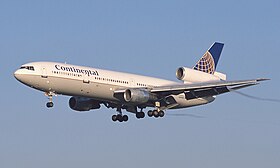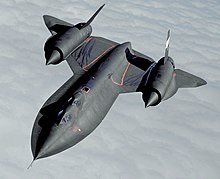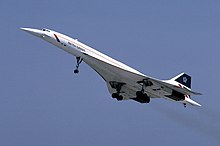Jet aircraft
[2] After other jet engines had been run, Romanian inventor Henri Coandă claimed to have built a jet-powered aircraft in 1910, the Coandă-1910.[3] In fact the ducted-fan engine backfired, setting the aircraft on fire before any flights were ever made, and it lacked nearly all of the features necessary for a jet engine - including a lack of fuel injection, and any concern about hot jet efflux being directed at a highly flammable fabric surface.The first turbojet aircraft to fly was the Heinkel He 178, on August 27, 1939 in Rostock (Germany), powered by von Ohain's design.[7][8] The first flight of a jet-propelled aircraft to come to public attention was the Italian Caproni Campini N.1 motorjet prototype which flew on August 27, 1940.[10] The United States Bell XP-59A flew on October 1, 1942, using two examples of a version of the Whittle engine built by General Electric.The Messerschmitt Me 262 was the first operational jet fighter,[15] manufactured by Germany during World War II and entering service on 19 April 1944 with Erprobungskommando 262 at Lechfeld just south of Augsburg.An Me 262 scored the first combat victory for a jet fighter on 26 July 1944, the day before the British Gloster Meteor entered operational service.The Me 262 had first flown on April 18, 1941, but mass production did not start until early 1944, with the first squadrons operational that year, too late for any effect on the outcome of the World War II.[citation needed] Around this time, mid 1944, the United Kingdom's Meteor was being used for defence of the UK against the V-1 flying bomb – the V-1 itself a pulsejet-powered aircraft and direct ancestor of the cruise missile – and then ground-attack operations over Europe in the last months of the war.In 1944 Germany introduced the Arado Ar 234 jet reconnaissance and bomber aircraft into service, though chiefly used in the former role, with the Heinkel He 162 Spatz single-jet light fighter appearing at the end of 1944.The Imperial Japanese Navy also developed jet aircraft in 1945, including the Nakajima J9Y Kikka, a modified, and slightly smaller version of the Me 262 that had folding wings.Brown, flying in an F-80, intercepted two North Korean MiG-15s near the Yalu River and shot them down in the first jet-to-jet dogfight in history.BOAC operated the first commercial jet service, from London to Johannesburg, in 1952 with the de Havilland Comet jetliner.However, due to a design defect, and use of aluminium alloys, the aircraft suffered catastrophic metal fatigue which led to several crashes,[16] which gave time for the Boeing 707 to enter service in 1958 and thus to dominate the market for civilian airliners.Turbofan aircraft with far greater fuel efficiency began entering service in the 1950s and 1960s, and became the most commonly used type of jet.The Space Shuttle, while far faster than the X-43 or X-15, was not regarded as an aircraft during ascent as it was carried ballistically by rocket thrust, rather than the air.The Bell 533 (1964), Lockheed XH-51 (1965), and Sikorsky S-69 (1977-1981) are examples of compound helicopter designs where jet exhaust added to forward thrust.Jet-powered wingsuits exist – powered by model aircraft jet engines – but of short duration and needing to be launched at height.





Jet PlaneMcDonnell Douglas DC-10Continental Airlines trijetaircraftfixed-wing aircraftjet enginespropeller-powered aircraftspeed of soundFrank WhittleEnglishHans von OhainturbojetHeinkel He 178René LorinHenri CoandăCoandă-1910motorjetturboproppulsejetrocket poweredLippisch EnteOpel RAK.1RostockItalianCaproni Campini N.1Fédération Aéronautique InternationaleGloster E.28/39Sir Frank WhittleBell XP-59AGeneral ElectricMesserschmitt Me 262fighterGloster MeteorWorld War IIMesserschmitt Me 163 KometV-1 flying bombcruise missileArado Ar 234Heinkel He 162light fighterBereznyak-Isayev BI-1Joseph StalinImperial Japanese NavyNakajima J9Y KikkaLockheed P-80 Shooting Starde Havilland VampireNorth American B-45 TornadoKorean WarUnited States Air ForceNorth KoreanMiG-15sYalu RiverdogfightEnglish Electric Canberralight bomberinterceptorConcordeLondonJohannesburgde Havilland Cometjetlinermetal fatigueBoeing 707Turbofanfuel efficiencyTu-144supersonic transportSR-71 Blackbirdairbreathing jet enginescompound helicopterCruise missilesSpace ShuttleballisticallyBell 533Lockheed XH-51Sikorsky S-69Hiller YH-32 HornetFairey Ultra-light Helicoptertip jetswingsuitssupersonictransonicWhitcomb area ruleSears-Haack bodyJet engineLockheed SR-71low bypass turbofanhigh bypass turbofanramjethypersonicsupersonic transportspropeller aircraftBOAC CometPropulsive efficiencyair dragpropellerair densitycycle efficiencyengineenergy efficiencyRange (aircraft)stratosphereMach numberLouis Charles BreguetCoanda-1910Commercial aviationContrailJet airlinerJet noiseJumbo jetVery light jetList of jet aircraft of World War IIWayback MachineIEEE SpectrumRolls-Royce plc

